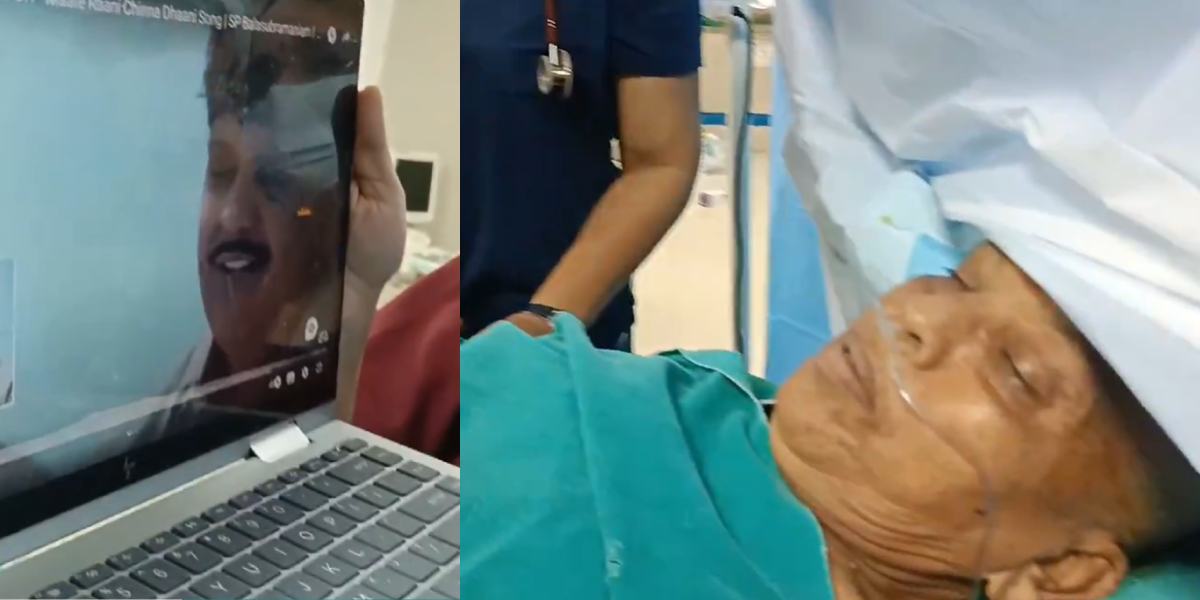At GMR Care Hospital in Andhra Pradesh, doctors successfully performed brain surgery on a 65-year-old woman, keeping her awake and calming her with beloved songs by SP Balasubrahmanyam
Published Oct 10, 2024 | 7:00 AM ⚊ Updated Oct 10, 2024 | 9:18 AM

Doctors at GMR Care Hospital in Rajam performed a successful brain surgery on a 65-year-old woman while she listened to SP Balasubrahmanyam.
In a remarkable display of the healing power of music, doctors at GMR Care Hospital in Rajam, Vizianagaram district of Andhra Pradesh, performed a successful brain surgery on a 65-year-old woman while she listened to the soothing melodies of legendary playback singer SP Balasubrahmanyam.
The patient was rushed to the hospital by her family after experiencing alarming symptoms of paralysis. Upon examination, doctors found bleeding in her brain, necessitating immediate surgical intervention. However, due to her advanced age and underlying health conditions, including a heart condition and asthma, the medical team faced a significant challenge: administering general anaesthesia posed too high a risk.
On 4 October, the surgical team decided to keep the patient awake throughout the procedure. To ease her anxiety and create a comforting atmosphere, they played some of her favourite songs, including the popular track Materani Chinnadani, sung by SP Balasubrahmanyam.
Doctors performed an “awake craniotomy” on the patient, a procedure involving surgery on the brain through an incision in the skull. During this type of surgery, the patient remains conscious.
“There are two primary reasons for opting for awake surgeries. First, when a tumour is located near “eloquent” areas of the brain—regions that control critical functions like vision, speech, or movement—keeping the patient awake allows the surgical team to monitor these abilities in real-time. If these areas are affected, the patient may face disabilities even if the tumour is successfully removed,” Hyderabad based Neurologist Dr Sudhir Kumar told South First.
Dr. Sudhir Kumar explained, “This approach helps ensure we don’t interfere with essential brain functions. Additionally, the brain itself lacks pain-sensitive structures, so it doesn’t feel pain. We anaesthetise the areas we need to pass through before reaching the brain.”
During an awake craniotomy, the first layer doctors encounter is the scalp, which is numbed using local anaesthesia to prevent pain. After cutting through the skin, they reach the skull bone, known as the periosteum, which is also pain-sensitive and requires anesthetisation. Next, they pass through the dura mater, a protective brain covering, which is also numbed.
Elderly woman undergoes brain surgery to the melodious sounds of SP Balasubrahmanyam in Vizianagaram, #AndhraPradesh
In a remarkable display of the healing power of music, doctors at GMR Care Hospital in Rajam, Vizianagaram district of Andhra Pradesh, performed a successful… pic.twitter.com/twmNKgFxC5
— South First (@TheSouthfirst) October 9, 2024
“Once these areas are anaesthetised, the surgeon can work on the brain tissue itself, which does not have pain receptors. Patients may still feel vibrations or movement, such as when the skull is drilled, so this procedure is typically done on calm and cooperative adults,” Dr Kumar said.
Dr. Kumar mentioned that awake craniotomies are often used when a tumour is near critical brain areas, or when patients cannot tolerate general anaesthesia due to conditions like heart problems. While the procedure is more complex and takes longer—around 1.5 to 2 hours—it’s crucial for patient safety. In this case, the patient’s internal brain bleeding required immediate surgery, and awake craniotomy was chosen to minimise risks.
Dr. Kumar emphasised the significant role music plays in awake surgeries. It is crucial for patients to remain cooperative and relaxed, as anxiety can hinder their ability to participate.
“Many find that listening to their favourite music helps ease their nerves. For patients, familiar songs create a sense of comfort and distraction from the surgical process.In surgical settings, music serves as a valuable diversion. Just as paediatric patients may be engaged with cartoons during procedures, adult patients in awake surgeries can focus on music to alleviate anxiety and enhance cooperation—both of which are vital for a successful outcome,” said Dr Kumar.
He said that awake craniotomies, where local anaesthesia is administered while the patient remains conscious, are generally gentler on the brain. Music not only promotes relaxation but also allows for better patient cooperation, contributing to enhanced safety. The surgeon can take necessary precautions to avoid damaging critical brain areas responsible for functions like vision, speech, and motor control.
However, Dr. Kumar pointed out that awake surgeries are not universally applied due to logistical challenges. These procedures take significantly longer and require patient cooperation. Even slight movements during surgery can affect the outcome. For instance, a hematoma removal might typically take 30 to 40 minutes when a patient is cooperative, while general anaesthesia allows for complete stillness, enabling the surgeon to focus solely on the operation.
Most surgeries are conducted under general anaesthesia, as it provides a controlled environment for the surgeon. However, awake surgeries are appropriate for certain cases, particularly when dealing with tumours in sensitive brain areas.
(Edited by Ananya Rao)
